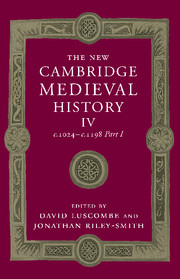Book contents
- Frontmatter
- 1 Introduction
- 2 The Rural Economy and Demographic Growth
- 3 Towns and the Growth of Trade
- 4 Government and Community
- 5 The Development of Law
- 6 Knightly Society
- 7 War, Peace and the Christian Order
- 8 The Structure of the Church, 1024–1073
- 9 Reform and the Church, 1073–1122
- 10 Religious Communities, 1024–1215
- 11 The Institutions of the Church, 1073–1216
- 12 Thought and Learning
- 13 Religion and the Laity
- 14 The Crusades, 1095–1198
- 15 The Eastern Churches
- 16 Muslim Spain and Portugal: Al-Andalus and its Neighbours
- 17 The Jews in Europe and the Mediterranean Basin
- 18 Latin and Vernacular Literature
- 19 Architecture and the Visual Arts
- List of Primary Sources
- Bibliography of secondary works arranged by chapter
- Index
- Frontispiece">
- Plate section"
- References
9 - Reform and the Church, 1073–1122
Published online by Cambridge University Press: 28 March 2008
- Frontmatter
- 1 Introduction
- 2 The Rural Economy and Demographic Growth
- 3 Towns and the Growth of Trade
- 4 Government and Community
- 5 The Development of Law
- 6 Knightly Society
- 7 War, Peace and the Christian Order
- 8 The Structure of the Church, 1024–1073
- 9 Reform and the Church, 1073–1122
- 10 Religious Communities, 1024–1215
- 11 The Institutions of the Church, 1073–1216
- 12 Thought and Learning
- 13 Religion and the Laity
- 14 The Crusades, 1095–1198
- 15 The Eastern Churches
- 16 Muslim Spain and Portugal: Al-Andalus and its Neighbours
- 17 The Jews in Europe and the Mediterranean Basin
- 18 Latin and Vernacular Literature
- 19 Architecture and the Visual Arts
- List of Primary Sources
- Bibliography of secondary works arranged by chapter
- Index
- Frontispiece">
- Plate section"
- References
Summary
‘we hope through [God’s] serenity to renew the lost light of truth and justice; to restore the health of the whole church, weakened to the point of ruin; to reform this iron age to one of gold with the hammer of just government.’ So Abbot William of Hirsau, the trusted adherent of Pope Gregory VII, described that pope’s reform programme in a letter to Hermann of Salm, who had been elected to the German kingship by the enemies of King Henry IV in 1081. ‘Above all you can begin to make a sacrifice of obedience most pleasing to the Lord by this means: if you labour to eradicate entirely the simoniac heresy, damned from eternity to all eternity; if you persevere in rooting out the deadly unchastity of clerks; and if you yourself avoid the transgression of conferring investitures of ecclesiastical offices.’ The duty of purifying the church of these evils belonged to the king; but it could be fulfilled only by a king who showed total obedience to the pope. As for Abbot William himself, his role in this work of reform was to pray every morning for the king’s success and to continue to ‘exhort and admonish’ him until the reform had been accomplished. This letter of William of Hirsau (whom Gregory VII regarded as a crucial figure in his reforming strategy in Germany) provides a useful introduction to the language of reform and renewal in the later eleventh century.
Keywords
- Type
- Chapter
- Information
- The New Cambridge Medieval History , pp. 268 - 334Publisher: Cambridge University PressPrint publication year: 2004
References
- 5
- Cited by

